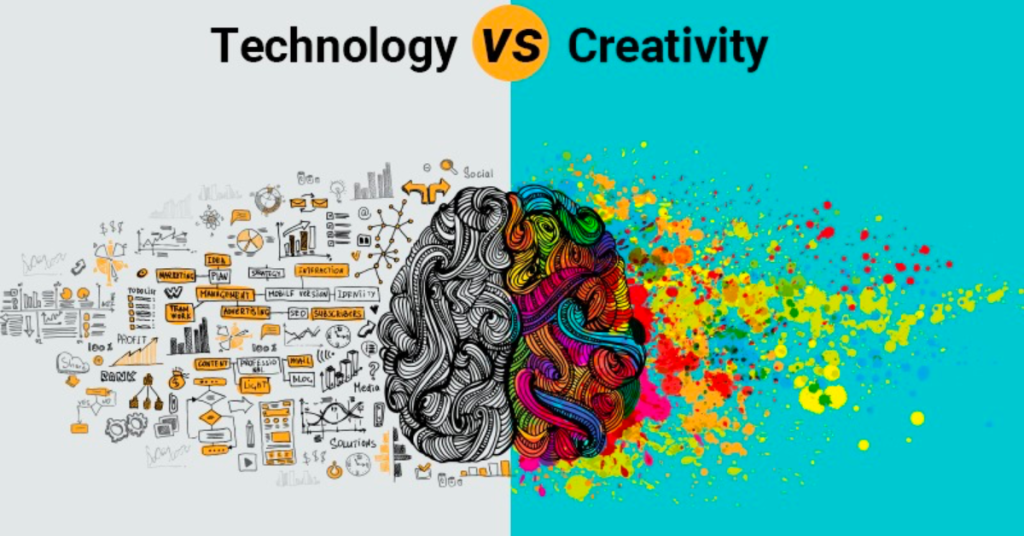Is Technology Limiting Creativity? Technology has a significant role in our daily lives. It has a strong impact on almost every aspect of our life. It has revolutionized communication, education, business, and entertainment.
In a society driven by modern technology, there is a growing concern about whether it is limiting creativity. Many have wondered if the internet, and social media platforms negatively impact our creative thinking.
Some people think that technology limits creativity. It distracts people and causes them to waste their precious hours scrolling through online platforms. They think people are wasting time on technology rather than doing some productive or creative things in their daily lives.
On the other hand, some people think that the growth of technology positively impacts creativity. It makes it easier for people to access any information.
While there are half-and-half views on this issue, it is essential to understand the link between technology and creativity. This article explores the pros and cons of technology’s impact on creativity, providing clarity on this complex and puzzling topic.
Defining Creativity and Technology
Before we delve into further discussion of the relationship between technology and creativity, it’s important to define terms.
“Creativity is the tendency to generate or recognize ideas, alternatives, or possibilities that may be useful in solving problems, communicating with others, and entertaining ourselves and others.”
“Technology is the application of scientific knowledge to the practical purposes of human life.”
Creativity helps us to explore new paths and possibilities. Creativity lights everything up. Everything we love and enjoy would not be as good without creativity. The world would probably be rather dull and boring.
Pros of Technology in Fostering Creativity
Access to Information and Inspiration
One of the significant advantages of technology is that it has given us easy access to valuable information and inspiration. The internet is a vast source of knowledge. It offers countless resources such as articles, blogs, research papers, images, videos, e-books, and tutorials. This ease of access allows individuals to explore diverse ideas and views, expanding their creative horizons.
Moreover, the Internet offers many sources where you can learn how to think creatively. It’s essential to have access to information when planning a creative output. Thanks to technology, we can do that anytime.
Tools for Creative Expression
Technological developments have given us a lot of tools specifically designed for creative expression. They include:
- Graphic design tools
- Music production tools
- Video editing tools
- Educational tools
- Digital learning tools
- Business tools
- Digital Art tools
These platforms allow individuals to bring their creative ideas to life. These tools boost productivity, efficiency, and experimentation. They enable artists and creators to expand the horizons of their imagination.
Collaboration and Feedback
Technology has transformed collaboration and feedback procedures. Creators can now connect with similar-minded individuals worldwide. It nurtures a sense of community and provides opportunities for collaboration.
Following are some creative professions:
- Architect
- Fashion designer
- Web Developer
- Film director
- Photographer
- Game designer
- Animator
- Jewelry designer
- Painter
Technology allows creators to share their work online and receive constructive feedback. They can engage in meaningful discussions. This constructive feedback and meaningful discussions ultimately enhance their creative growth. Online platforms like social media and other dedicated creative communities are of great help to creative people.
Read Now:How To Choose The Right Technology Stack For Your Business?
Automation and Efficiency
Automation and digital tools have simplified many time-consuming tasks. And allowed creators to focus more on their creative course. Automation boosts innovation and creativity by automating routine and repetitive tasks. In this way, creators have more time to focus on more complex and creative tasks.
In the business world, technology has increased efficiency by freeing up valuable time and energy. With the help of automation, you have more time to focus on developing new products or services, exploring new business ideas, and refining current ideas.
Generation of new ideas
The meaning of creativity goes beyond just creating something new from scratch. It also involves improving and advancing old ideas. The Internet is one of the best places to find creative possibilities.
Technological innovations also give people new ideas and insights. This motivates people to explore and develop more creative ideas. It can lead to solving numerous problems. Additionally, technology boosts innovation.
Cons of Technology as a Barrier to Creativity
Distraction and Overstimulation
The constant invasion of information, notifications, and entertainment options can distract you away from creative recreation. A significant amount of time can be wasted on social media, online streaming, and video games.
Lack of Tangibility and Authenticity
Digital platforms also have certain limitations. For some creators, physicality and tangibility is a necessity. Like painting and sculpting that need the physicality of their craft. Online creations cannot provide a sense of authenticity to certain creators’ works.
Dependency on Templates and Presets
The easy accessibility of technology can sometimes result in over-reliance on templates and presets. These tools can be helpful for beginners. They can also hold back originality and innovation. Relying too much on pre-existing designs and patterns may hinder the exploration of unique ideas and creativity.
Loss of Serendipity and Unpredictability
Technology often provides personalized recommendations and experiences based on user liking. While this can enhance user satisfaction, it may also limit exposure to new ideas and perceptions. Serendipitous encounters and unexpected discoveries have long been reasons for creative discoveries.
Finding Balance: Embracing Technology for Creativity
To maximize the advantages of technology while minimizing its restrictions, finding a balance is essential. Here are some tactics to embrace technology in a way that fosters creativity:
Mindful Technology Use
Practice mindful and deliberate use of technology. You can set time limits for internet use. You should keep time aside for uninterrupted creative work.
Hybrid Approaches
A combination of traditional and digital mediums can benefit you in a unique way. For example, you can combine physical art practices with digital editing.
Seek Unconventional Sources
You can make time to explore nature. You can read books, go to art exhibitions, and engage in one-to-one discussions with people.
Step Outside Comfort Zones
Challenge yourself to experiment with new things. This makes way for innovation and creativity. Embrace the discomfort of the unknown to open new possibilities of creativity.
Cultivate Offline Creativity
Dedicate regular time away from screens to engage in activities that stimulate creativity. These include journaling, meditating, taking walks, or pursuing hobbies unrelated to technology.
Conclusion
Technology undoubtedly has the power to both enhance and limit creativity. It provides unprecedented access to information, tools for expression, and opportunities for collaboration. However, it also presents challenges such as distraction, dependency, and the loss of serendipity. By understanding these pros and cons, individuals can harness technology’s potential while being mindful of its impact. Striking a balance between embracing technology and nurturing creativity in offline experiences can lead to a harmonious and thriving creative journey.
FAQs
Creativity initiates ideas, technology empowers them. Steve Jobs believes that the best way to create value is to connect creativity with technology.
Use social media to enhance your creativity by following accounts, hashtags, or groups that are relevant to your interests, passions, or goals.
The internet gives people direct access to information which can inspire creativity.
Computer graphics
Video production
Digital music
Digital cinematography
Virtual reality, etc.
Michael C Vang is a passionate blogger. He has been blogging since 2013 on a variety of topics. He is committed to creating informative and engaging content that helps readers learn more about everything.



